| UNITED STATES |
| SECURITIES AND EXCHANGE COMMISSION |
| Washington, D.C. 20549 |
| |
FORM N-CSR |
| |
CERTIFIED SHAREHOLDER REPORT OF REGISTERED |
MANAGEMENT INVESTMENT COMPANIES |
| |
| |
| |
| Investment Company Act File Number: 811-4521 |
|
| |
| T. Rowe Price State Tax-Free Income Trust |
|
| (Exact name of registrant as specified in charter) |
| |
| 100 East Pratt Street, Baltimore, MD 21202 |
|
| (Address of principal executive offices) |
| |
| David Oestreicher |
| 100 East Pratt Street, Baltimore, MD 21202 |
|
| (Name and address of agent for service) |
| |
| |
| Registrant’s telephone number, including area code: (410) 345-2000 |
| |
| |
| Date of fiscal year end: February 28 |
| |
| |
| Date of reporting period: February 28, 2011 |
Item 1: Report to Shareholders| New York Tax-Free Money Fund | February 28, 2011 |
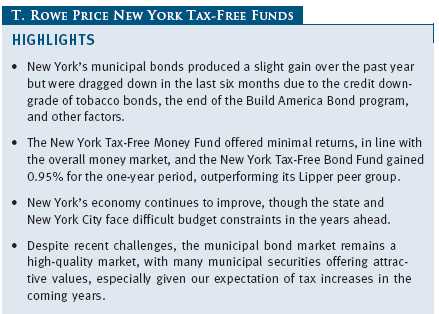
The views and opinions in this report were current as of February 28, 2011. They are not guarantees of performance or investment results and should not be taken as investment advice. Investment decisions reflect a variety of factors, and the managers reserve the right to change their views about individual stocks, sectors, and the markets at any time. As a result, the views expressed should not be relied upon as a forecast of the fund’s future investment intent. The report is certified under the Sarbanes-Oxley Act, which requires mutual funds and other public companies to affirm that, to the best of their knowledge, the information in their financial reports is fairly and accurately stated in all material respects.
REPORTS ON THE WEB
Sign up for our E-mail Program, and you can begin to receive updated fund reports and prospectuses online rather than through the mail. Log in to your account at troweprice.com for more information.
Manager’s Letter
Fellow Shareholders
New York tax-free municipal bonds produced modest gains in the 12-month period ended February 28, 2011, but were dragged down in the second half of the year by falling bond prices. The nearly flat returns of New York tax-free money market securities reflected the Federal Reserve’s continued determination to keep short-term interest rates near 0%. Several factors pressured municipal yields higher and bond prices lower in the last six months, including reduced investor demand for municipal securities as yields approached historic lows last summer, signs of economic improvement, bipartisan legislation to extend the Bush-era tax cuts for two years, rising rates for longer-term U.S. Treasuries, and heavy issuance ahead of the expiration of the Build America Bond (BAB) program at the end of 2010. Municipal securities also were beset by key ratings downgrades of popular tobacco bonds sold by states and backed by payments from tobacco companies. New York continues to face numerous challenges, and the New York Tax-Free Bond Fund posted a modest return in this environment while the New York Tax-Free Money Fund was roughly flat for the period.
MARKET ENVIRONMENT
Despite high national unemployment and generally weak housing markets, the U.S. economy is growing at a steady and sustainable pace. Exports and manufacturing activity have been strong, confidence among consumers and businesses has been increasing, and fears of a double-dip recession are waning, thanks in part to additional monetary and fiscal stimulus. In early November, the Federal Reserve initiated a second round of quantitative easing to drive down long-term interest rates and spur economic growth through the purchases of $600 billion in Treasuries by June. In December, the government extended federal tax cuts through the end of 2012 and reduced payroll taxes through 2011, providing additional stimulus.
Intermediate and long-term Treasury interest rates have risen sharply over the last six months, reflecting expectations for stronger economic growth in 2011 and concerns about higher inflation stemming from food and energy price increases. In addition, the Fed signaled—contrary to expectations—that it would not make significant purchases of bonds maturing in 30 years. Longer-term municipal interest rates also rose significantly, tracking Treasury yields and reflecting heavier municipal supply and weaker demand, particularly in the last two months of 2010.
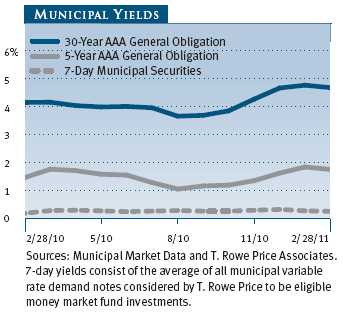
With 30-year municipal yields higher than 30-year Treasury yields, long-term tax-free securities are an attractive alternative, particularly for investors in the highest tax brackets. As of February 28, 2011, the 4.69% yield offered by a 30-year tax-free municipal bond rated AAA was about 104% of the 4.50% pretax yield offered by a 30-year Treasury. An investor in the 28% federal tax bracket would need to invest in a taxable bond yielding about 6.51% in order to receive the same after-tax income. (To calculate a municipal bond’s taxable-equivalent yield, divide the municipal bond’s yield by the quantity of 1.00 minus your federal tax bracket expressed as a decimal—in this case, 1.00 – 0.28, or 0.72.)
MUNICIPAL MARKET NEWS
Nationally, new municipal supply through the end of 2010 totaled about $433 billion—an annual record—according to The Bond Buyer. Tax-exempt supply for most of the year reflects a steady pace of municipal borrowings for ongoing capital needs. Issuance increased significantly in the fourth quarter as municipalities rushed to take advantage of favorable market conditions and low interest rates. Investor demand remained strong, bolstered by concerns about higher federal, state, and local taxes. However, cash flows into municipal bond funds turned negative in early November, which weakened institutional demand. About 30% of new supply in 2010 represented taxable municipal issuance under the BAB program, which puts supply of new tax-exempt securities at constricted levels. Because the BAB program was not extended beyond the end of 2010, some municipalities accelerated their 2011 borrowing into late 2010, and new aggregate issuance thus far in 2011 has been muted, in part because of higher long-term municipal rates.
New York and other states continue to face fiscal difficulties and have been forced to raise taxes and fees and cut spending to close budget deficits. Despite the increasing negative press regarding their fiscal health, we do not see a near-term threat to the states’ ability to continue servicing their outstanding debts, though we have longer-term concerns about potentially onerous future pension obligations. In any event, the fiscal woes of state governments do not necessarily limit our tax-free investment opportunities. Many municipal market issuers continue to maintain good credit profiles.
For the 12-month period, most municipal sectors produced mild gains as losses in the second half of our fiscal year offset strong gains in the first half. Over the last year, general obligations (GOs) bonds, particularly state-issued GOs, outperformed revenue bonds, although gains in both segments were not spectacular. Among revenue bonds, housing, solid waste, and lease revenue were among the top-performing segments. In contrast, industrial revenue issues produced slight negative returns, weighed down by tobacco bonds. While transportation and health care-related bonds generally lagged, some lower-quality issues within those sectors did quite well.
In the last six months, virtually every major municipal bond sector produced negative returns, with GOs holding up somewhat better than revenue bonds. Among revenue bonds, tobacco bonds dragged down the industrial revenue sector. We are underweighting tobacco bonds because fundamentals are poor and longer-term tobacco consumption trends do not appear to be especially positive for the bonds. However, we like other credits in the industrial revenue space. Transportation- and education-related bonds fared poorly, as did hospital revenue and life-care issues. We remain cautious on health care, in part because last year’s reform legislation will lead to tighter reimbursement policies and state budget cuts could affect Medicaid payments to providers. However, we believe the sector offers attractive investment opportunities with reasonable credit risks. Housing revenue bonds held up fairly well, and prerefunded and escrowed-to-maturity bonds, which are backed by Treasuries, declined the least.
NEW YORK MARKET NEWS
The New York state employment picture brightened during the past year, though at a lackluster pace. While the state’s nonfarm employment levels increased, so did its unemployment rate, owing to more people looking for work. Employment in the public and private sectors increased by 45,500, or 0.5%, in the full year through January 2011—the latest data available. Educational and health services led employment gains among the major sectors in 2010, followed by professional and business services. Government payrolls fell by 30,500 during the year. Statewide, the unemployment rate in January 2011 stood at 8.3%—well below the national average of 9.0%. In New York City, the unemployment rate in January was 8.9%. New York maintains above-average wealth levels with 2009 per capita personal income at 120% of the nation, ranking fourth highest among the states.
Moody’s Investors Service rates New York’s GOs Aa2, while S&P and Fitch Ratings both rate the bonds AA. All three agencies maintain “stable” outlooks, indicating that a near-term change in the rating is not expected.
The state’s fiscal condition remains murky. Newly elected Governor Andrew Cuomo submitted his 2012 budget proposal to the state legislature on February 1, 2011. The $133 billion plan contains $8.9 billion in spending cuts compared with the previous year. However, only about half of those cuts are detailed, leaving uncertainty about the scope of much of the budget. No income tax increases are included in the governor’s plan. The state’s general fund ended fiscal 2010 with a net loss of 1.3% of revenues, though it expected to end the year in balance due to revisions and the use of money in its reserves fund.
New York’s debt burden is among the highest in the nation, according to Moody’s. Unlike many other states, however, New York’s pension funds are well financed. The majority of New York’s debt is appropriation backed, which means that the legislature must approve debt service payments on these obligations annually, but it has no legal obligation to continue to consent to these expenses.
New York City continues to feel the effects from the economic slowdown but has demonstrated strong fiscal management, including multiyear financial planning and a roll forward of its budget surplus from stronger years. On a budgetary basis, the city is forecasting that fiscal 2011 will end with a $3.2 billion surplus (4.8% of revenues), which will be rolled forward to help balance fiscal 2012. Mayor Michael Bloomberg presented his fiscal 2012 budget of $66 billion in mid-February. Property taxes remain the city’s largest revenue source and act as a stabilizing factor given the city’s practice of phasing in tax assessments over five years. Still, the city faces budget gaps of $4.9 billion in fiscal 2013, $4.8 billion in fiscal 2014, and $5.0 billion in fiscal 2015. Agency ratings for New York City are Aa2 from Moody’s, AA from S&P, and AA from Fitch, all with stable outlooks.
PORTFOLIO STRATEGIES
New York Tax-Free Money Fund
Your fund returned 0.01% for both the 6- and 12-month periods ended February 28, 2011. The fund’s returns were slightly behind those of its Lipper benchmark, but returns for money market funds of all types have hovered near 0%.
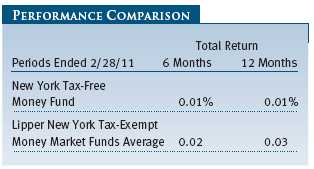
An unchanged Federal Reserve policy, which has targeted a fed funds rate of 0.00% to 0.25% since late 2008, continues to compress all money market rates. All money market instruments—including Treasuries, agencies, corporates, and municipals—continue to trade in a very narrow range around the fed funds target rate. The result has been a continuation of paltry yields for all money fund investors.
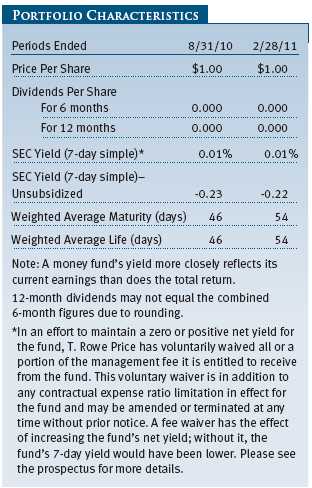
Although meager, municipal money market rates have tended to trade above taxable rates and have remained fairly steady over the past six months. Yields have averaged around 0.22% for overnight and seven-day investments, 0.30% for 90 days, and 0.35% for the one-year period. Thus, an investment anywhere along the municipal money market yield curve continues to generate income insufficient to meet fund expenses.
With a relatively flat, range-bound yield curve—that is, a fairly steady relationship between short- and longer-term yields—and our expectation of little change in rates for the foreseeable future, we sought to position the fund near the longer end of our permissible range. Our higher-than-normal allocation to longer-dated, fixed rate issues versus variable rate investments has gained us some small yield advantage. More recently we have found fewer opportunities to extend the fund’s weighted average maturity and we end the period somewhat shorter than our target.
We remain very cautious on credit given the state’s ongoing fiscal problems, which color our view of many local issuers dependent upon the state for appropriations. Our money market investment policy has always been focused on only the highest-quality issuers who are deemed to present minimal credit risk or those issues that carry additional support in the form of bank liquidity. Thus, among our largest positions you will find New York City Transitional Finance Authority, Port Authority of New York and New Jersey, and New York State Personal Income Tax securities. (Please refer to the fund’s portfolio of investments for a complete list of our holdings and the amount each represents in the portfolio.)
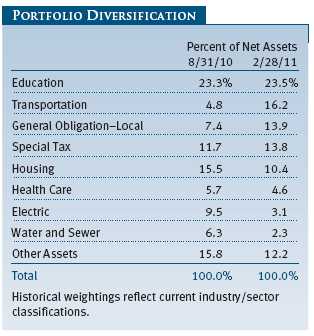
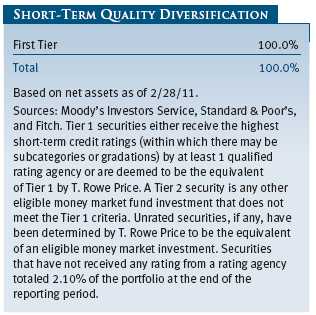
We expect most money market rates to remain unchanged through 2011, which will keep returns extremely low for municipal money market funds. A rebounding economy ultimately will improve the near-term financial prospects of many municipal issuers, but for now we are cautious. Thus, our investment posture is expected to remain relatively unchanged for the next three to six months.
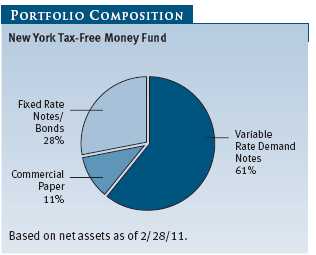
New York Tax-Free Bond Fund
Your fund returned -3.97% and 0.95% for the 6- and 12-month periods ended February 28, 2011, respectively. These returns exceeded those of our Lipper peer group average due to our relatively defensive positioning and careful credit selection. The fund’s long-term record relative to its competitors also remains favorable. (Based on cumulative total return, Lipper ranked the New York Tax-Free Bond Fund 27 out of 98, 33 out of 91, 24 out of 85, and 18 out of 75 New York state municipal debt funds for the 1-, 3-, 5-, and 10-year periods ended February 28, 2011, respectively. Returns will vary for other periods. Past performance cannot guarantee future results.)
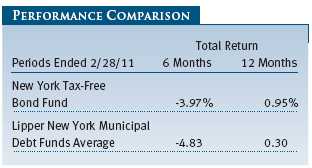
Market conditions in the tax-exempt market reversed course since our last shareholder report. Interest rates ratcheted significantly higher over the past six months. Record cash inflows turned into extraordinary outflows from the municipal market as the media focused on concerns over the financial health of states and localities. The sell-off was exacerbated by the credit rating downgrades of popular tobacco bonds sold by states and backed by payments from tobacco companies, as well as by the elevated supply in the fourth quarter due to the BAB program’s year-end expiration and investors’ disappointed hopes that the program would be extended. The sell-off occurred across the range of maturities, but longer-dated issues saw greater valuation declines as an already steep yield curve steepened even more. As of this writing, however, fears of unmanageable new supply in the traditional tax-exempt market from issuers no longer able to tap the BAB program have not come to fruition. With new issue supply falling well below estimates, the market has been able to regain some footing and redemptions have subsided.
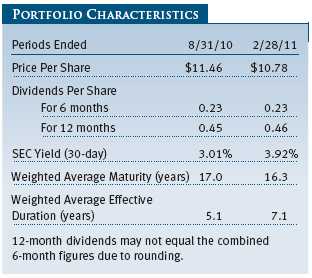
Our investment strategy has remained intact over the past year, with an overweight to longer-term maturities as the steep yield curve made long-term rates much more compelling. Additionally, yields relative to taxable securities for longer-dated bonds were much more attractive than for short- and intermediate-term securities. As a result, the fund is underweighted in the 3- to 10-year range and has an overweight in longer-term issues relative to the Barclays Capital Municipal Bond Index. The bias toward the longer-term issues did not help returns on a relative basis as the best-performing securities were those maturing in five to 10 years. Despite our continuing focus on longer-term issues, the fund’s weighted average maturity declined slightly, from 17.0 years to 16.3 years over the past six months as we sold longer-dated bonds.

The fund’s duration—a measure of its sensitivity to changes in interest rates—was slightly shorter than that of its peers for most of the period and lengthened from 5.1 to 7.1 years as rates moved higher since August. The fund’s 30-day SEC yield also rose from 3.01% to 3.92%. The fund’s overall quality diversification was relatively unchanged, although we increased our exposure to AAA rated bonds by four percentage points to 12% of the portfolio, while AA rated bonds declined by five percentage points to 44%. The fund remains a high-quality portfolio with 82% of securities rated A and higher.
We became net sellers in the latter half of the year as fund redemptions took hold among municipal funds. Liquidity for New York tax-exempt paper fared much better than the general market. This can be attributed to the decline in overall new state supply in the past year, as many of New York’s large issuers opted to finance through the taxable BAB program. The dynamics may shift because the program has expired and these issuers are returning to the traditional tax-exempt market. Many sales were driven by retail demand, with a focus on decreasing exposure in bonds with shorter calls and less attractive coupons.
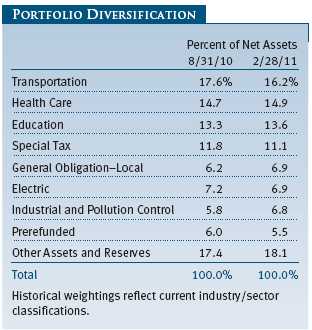
The fund’s largest allocation is to the transportation sector, followed by health care, which offers significantly higher yields relative to other sectors with comparable ratings. We have selectively invested in individual issues that we have deemed appropriate through our in-house analysts’ fundamental credit research. Education remains the third-largest sector as the state has an abundance of well-regarded institutions that issue tax-exempt debt. We favor revenue bonds and remain underweight relative to the benchmark in GO debt as the state still faces a substantial budget imbalance. We have even greater concerns surrounding local GOs, which may face increased challenges as revenue flows from the state continue to be squeezed.
The fund benefited by its smaller allocation versus the benchmark in the tobacco sector, which significantly lagged the general market. The fund’s biggest underperformers were mostly long-duration bonds that were newly issued and purchased in the late summer and early fall. Away from bonds in the intermediate range of the curve, top performers included lower-quality holdings in the industrial revenue and pollution control sector, as well as hospitals and life care.
OUTLOOK
The last six months was a challenging period for the municipal bond market, but not because of defaults or credit-related events. In the late fall, municipal interest rates rose initially along with Treasury rates on inflation worries due to Federal Reserve activity. Municipal market weakness quickly accelerated as investors, with nagging credit fears and concerns about municipal market stability, redirected a significant amount of assets to other investment areas. We understand that many of you continue to have concerns about the stability of the market and the potential for widespread defaults. We do not agree with the dire predictions made in some media stories that there will be significant municipal defaults in the near term. As always, we will rely on our ongoing research and analysis to direct our investments to areas of the municipal market in which we see good long-term value.
Still, the current credit and economic environment for municipalities is the most challenging since the Great Depression and could remain so for some time. Ongoing economic sluggishness, the housing market downturn, and high unemployment have reduced the tax revenues collected by state and local governments, and municipal bond defaults, which have historically been rare, could increase moderately. Furthermore, long-term state and local government liabilities such as pension benefits and health care costs are a growing concern. Maintaining balanced budgets and addressing these long-term concerns require careful and dedicated work by state and local officials. Many issuers are trying to make the difficult but necessary fiscal decisions as they adjust to high unemployment, slow economic growth, lower tax revenues, and other tough conditions. These efforts will need to continue—with or without additional federal government assistance.
We continue to believe that the municipal bond market remains a high-quality market and that many municipal securities offer good long-term value, especially given that tax rates are expected to rise in the next few years. While shorter-term securities have unattractive absolute yields and could be vulnerable if shorter-term interest rates increase, longer-term and lower-rated investment-grade bond valuations have become more attractive in recent months and should stabilize as supply pressures abate. Some municipalities have canceled or delayed bond issuance due to the difficult market conditions. We expect demand for municipals to increase as taxable bond portfolios or other nontraditional investors decide to take advantage of higher municipal yields.
We believe T. Rowe Price’s strong credit research capabilities have been and will remain an asset for our investors. We continue to conduct our own thorough research and assign our own independent credit ratings before making investment decisions. As always, we are on the lookout for attractively valued bonds issued by municipalities with good fundamentals. We think such investments will continue to help us generate excellent long-term relative returns for our clients.
Respectfully submitted,

Joseph K. Lynagh
Chairman of the Investment Advisory Committee
New York Tax-Free Money Fund

Konstantine B. Mallas
Chairman of the Investment Advisory Committee
New York Tax-Free Bond Fund
March 11, 2011
The committee chairmen have day-to-day responsibility for managing the portfolios and work with committee members in developing and executing the funds’ investment programs.
RISKS OF FIXED INCOME INVESTING
Since money market funds are managed to maintain a constant $1.00 share price, there should be little risk of principal loss. However, there is no assurance the fund will avoid principal losses if fund holdings default or are downgraded or if interest rates rise sharply in an unusually short period. In addition, the fund’s yield will vary; it is not fixed for a specific period like the yield on a bank certificate of deposit. An investment in the fund is not insured or guaranteed by the Federal Deposit Insurance Corporation (FDIC) or any other government agency. Although a money market fund seeks to preserve the value of your investment at $1.00 per share, it is possible to lose money by investing in it. Bonds are subject to interest rate risk (the decline in bond prices that usually accompanies a rise in interest rates) and credit risk (the chance that any fund holding could have its credit rating downgraded or that a bond issuer will default by failing to make timely payments of interest or principal), potentially reducing the fund’s income level and share price.
GLOSSARY
Barclays Capital Municipal Bond Index: A broadly diversified index of tax-exempt bonds.
Basis points: One hundred basis points equal one percentage point.
Duration: A measure of a bond fund’s sensitivity to changes in interest rates. For example, a fund with a duration of six years would fall about 6% in price in response to a one-percentage-point rise in interest rates, and vice versa.
Fed funds rate: An overnight lending rate set by the Federal Reserve and used by banks to meet reserve requirements. Banks also use the fed funds rate as a benchmark for their prime lending rates.
General obligation debt: A government’s strongest pledge that obligates its full faith and credit, including, if necessary, its ability to raise taxes.
Investment grade: High-quality bonds as measured by one of the major credit rating agencies. For example, Standard & Poor’s designates the bonds in its top four categories (AAA to BBB) as investment grade.
Lipper averages: The averages of available mutual fund performance returns for specified time periods in defined categories as tracked by Lipper Inc.
Revenue (or revenue-backed) bond: A bond issued to fund specific projects, such as airports, bridges, hospitals, and toll roads, where a portion of the revenue generated is used to service the interest payments on the bond.
SEC yield (7-day simple): A method of calculating a money fund’s yield by annualizing the fund’s net investment income for the last seven days of each period divided by the fund’s net asset value at the end of the period. Yield will vary and is not guaranteed.
SEC yield (30-day): A method of calculating a fund’s yield that assumes all securities are held until maturity. Yield will vary and is not guaranteed.
Weighted average life: The dollar-weighted average maturity of a portfolio’s securities without taking into account interest rate reset dates for certain adjustable rate securities. It is a measure that reflects how a fund may react in periods when credit spreads are widening or liquidity conditions are tightening. In general, the longer the fund’s average life, the greater its exposure to interest rate fluctuations. Money funds must maintain a weighted average life of less than 120 days.
Weighted average maturity: In general, the longer the average maturity, the greater the fund’s sensitivity to interest rate changes. The weighted average maturity may take into account the interest rate readjustment dates for certain securities. Money funds must maintain a weighted average maturity of less than 60 days.
Yield curve: A graphic depiction of the relationship among the yields for similar bonds with different maturities. A yield curve is positive when short-term yields are lower than long-term yields and negative when short-term yields are higher than long-term yields.
Performance and Expenses
This chart shows the value of a hypothetical $10,000 investment in the fund over the past 10 fiscal year periods or since inception (for funds lacking 10-year records). The result is compared with benchmarks, which may include a broad-based market index and a peer group average or index. Market indexes do not include expenses, which are deducted from fund returns as well as mutual fund averages and indexes.
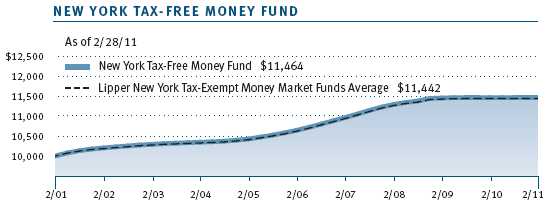

This chart shows the value of a hypothetical $10,000 investment in the fund over the past 10 fiscal year periods or since inception (for funds lacking 10-year records). The result is compared with benchmarks, which may include a broad-based market index and a peer group average or index. Market indexes do not include expenses, which are deducted from fund returns as well as mutual fund averages and indexes.
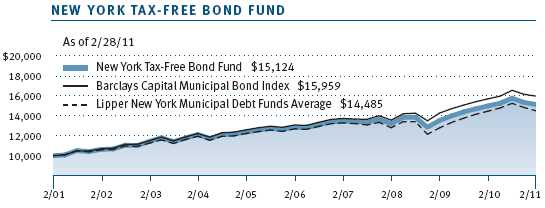

As a mutual fund shareholder, you may incur two types of costs: (1) transaction costs, such as redemption fees or sales loads, and (2) ongoing costs, including management fees, distribution and service (12b-1) fees, and other fund expenses. The following example is intended to help you understand your ongoing costs (in dollars) of investing in the fund and to compare these costs with the ongoing costs of investing in other mutual funds. The example is based on an investment of $1,000 invested at the beginning of the most recent six-month period and held for the entire period.
Actual Expenses
The first line of the following table (“Actual”) provides information about actual account values and expenses based on the fund’s actual returns. You may use the information in this line, together with your account balance, to estimate the expenses that you paid over the period. Simply divide your account value by $1,000 (for example, an $8,600 account value divided by $1,000 = 8.6), then multiply the result by the number in the first line under the heading “Expenses Paid During Period” to estimate the expenses you paid on your account during this period.
Hypothetical Example for Comparison Purposes
The information on the second line of the table (“Hypothetical”) is based on hypothetical account values and expenses derived from the fund’s actual expense ratio and an assumed 5% per year rate of return before expenses (not the fund’s actual return). You may compare the ongoing costs of investing in the fund with other funds by contrasting this 5% hypothetical example and the 5% hypothetical examples that appear in the shareholder reports of the other funds. The hypothetical account values and expenses may not be used to estimate the actual ending account balance or expenses you paid for the period.
Note: T. Rowe Price charges an annual small-account maintenance fee of $10, generally for accounts with less than $2,000 ($500 for UGMA/UTMA). The fee is waived for any investor whose T. Rowe Price mutual fund accounts total $25,000 or more, accounts employing automatic investing, and IRAs and other retirement plan accounts that utilize a prototype plan sponsored by T. Rowe Price (although a separate custodial or administrative fee may apply to such accounts). This fee is not included in the accompanying table. If you are subject to the fee, keep it in mind when you are estimating the ongoing expenses of investing in the fund and when comparing the expenses of this fund with other funds.
You should also be aware that the expenses shown in the table highlight only your ongoing costs and do not reflect any transaction costs, such as redemption fees or sales loads. Therefore, the second line of the table is useful in comparing ongoing costs only and will not help you determine the relative total costs of owning different funds. To the extent a fund charges transaction costs, however, the total cost of owning that fund is higher.
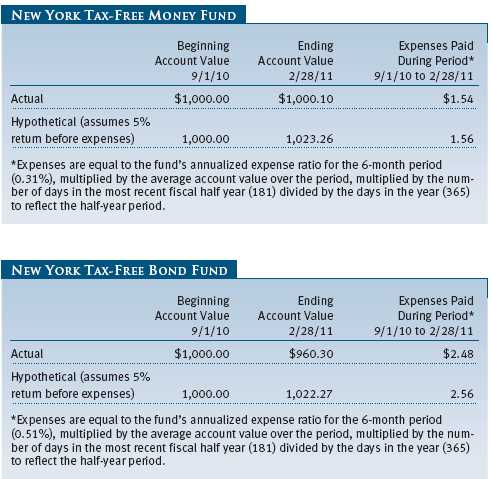
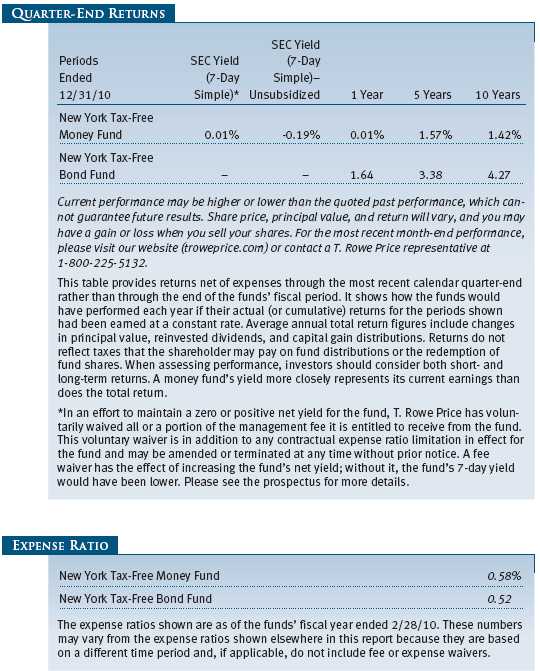
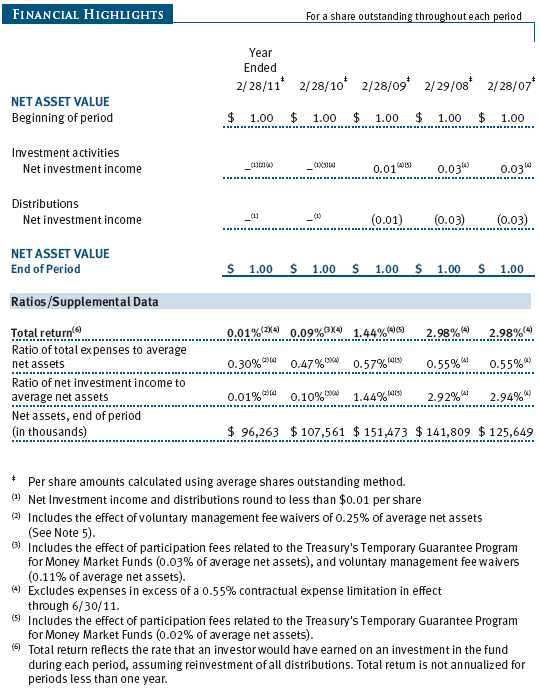
The accompanying notes are an integral part of these financial statements.
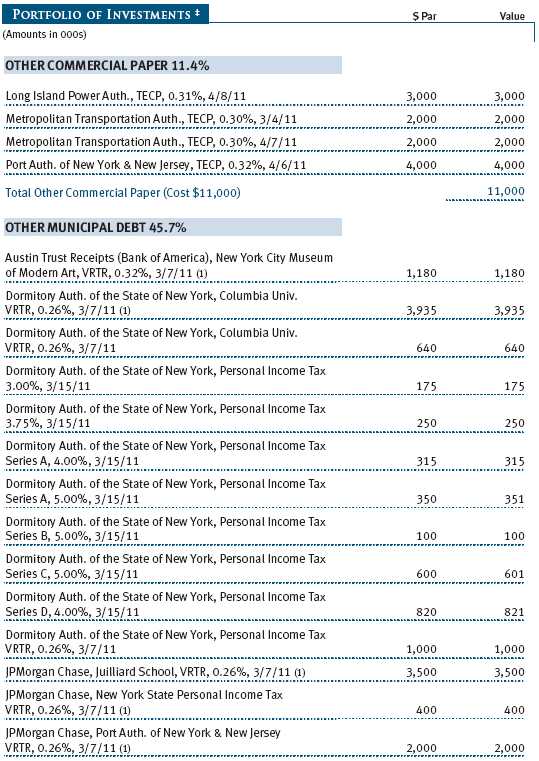
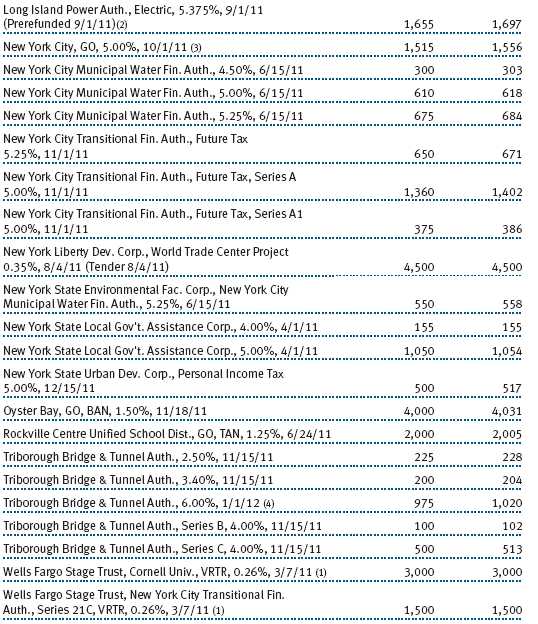
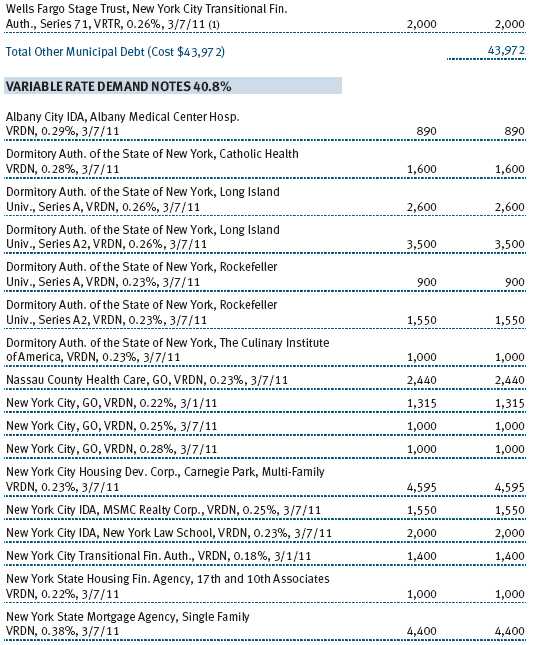
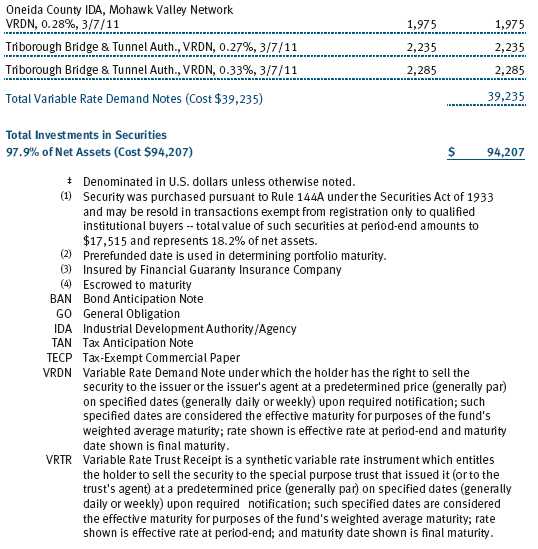
The accompanying notes are an integral part of these financial statements.

The accompanying notes are an integral part of these financial statements.
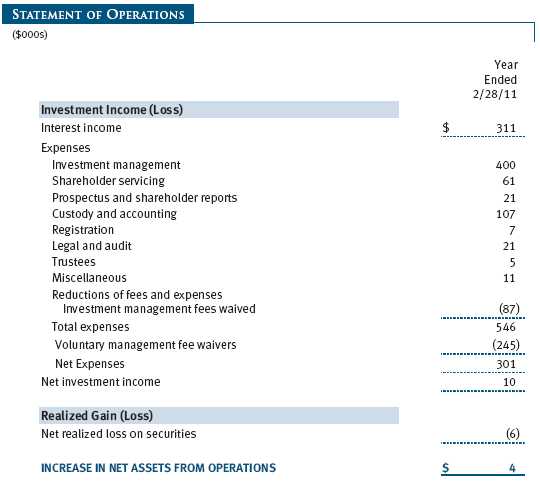
The accompanying notes are an integral part of these financial statements.
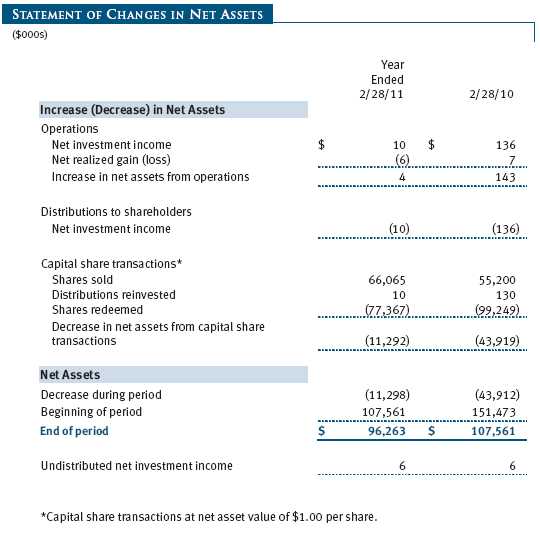
The accompanying notes are an integral part of these financial statements.
| NOTES TO FINANCIAL STATEMENTS |
T. Rowe Price State Tax-Free Income Trust (the trust), is registered under the Investment Company Act of 1940 (the 1940 Act). The New York Tax-Free Money Fund (the fund), a nondiversified, open-end management investment company, is one portfolio established by the trust. The fund commenced operations on August 28, 1986. The fund seeks to provide preservation of capital, liquidity, and, consistent with these objectives, the highest level of income exempt from federal, New York state, and New York City income taxes.
NOTE 1 - SIGNIFICANT ACCOUNTING POLICIES
Basis of Preparation The accompanying financial statements were prepared in accordance with accounting principles generally accepted in the United States of America, which require the use of estimates made by management. Management believes that estimates and valuations are appropriate; however, actual results may differ from those estimates, and the valuations reflected in the accompanying financial statements may differ from the value ultimately realized upon sale or maturity.
Investment Transactions, Investment Income, and Distributions Income and expenses are recorded on the accrual basis. Premiums and discounts on debt securities are amortized for financial reporting purposes. Income tax-related interest and penalties, if incurred, would be recorded as income tax expense. Investment transactions are accounted for on the trade date. Realized gains and losses are reported on the identified cost basis. Distributions to shareholders are recorded on the ex-dividend date. Income distributions are declared daily and paid monthly.
Credits The fund earns credits on temporarily uninvested cash balances held at the custodian, which reduce the fund’s custody charges. Custody expense in the accompanying financial statements is presented before reduction for credits.
NOTE 2 - VALUATION
The fund values its investments and computes its net asset value per share each day that the New York Stock Exchange is open for business. In accordance with Rule 2a-7 under the 1940 Act, securities are valued at amortized cost, which approximates fair value. Securities for which amortized cost is deemed not to reflect fair value are stated at fair value as determined in good faith by the T. Rowe Price Valuation Committee, established by the fund’s Board of Trustees.
Various inputs are used to determine the value of the fund’s financial instruments. These inputs are summarized in the three broad levels listed below:
Level 1 – quoted prices in active markets for identical financial instruments
Level 2 – observable inputs other than Level 1 quoted prices (including, but not limited to, quoted prices for similar financial instruments, interest rates, prepayment speeds, and credit risk)
Level 3 – unobservable inputs
Observable inputs are those based on market data obtained from sources independent of the fund, and unobservable inputs reflect the fund’s own assumptions based on the best information available. The input levels are not necessarily an indication of the risk or liquidity associated with financial instruments at that level. For example, securities held by a money market fund are generally high quality and liquid; however, they are reflected as Level 2 because the inputs used to determine fair value are not quoted prices in an active market. On February 28, 2011, all of the fund’s financial instruments were classified as Level 2, based on the inputs used to determine their values.
NOTE 3 - OTHER INVESTMENT TRANSACTIONS
Consistent with its investment objective, the fund engages in the following practices to manage exposure to certain risks and/or to enhance performance. The investment objective, policies, program, and risk factors of the fund are described more fully in the fund’s prospectus and Statement of Additional Information.
Restricted Securities The fund may invest in securities that are subject to legal or contractual restrictions on resale. Prompt sale of such securities at an acceptable price may be difficult and may involve substantial delays and additional costs.
NOTE 4 - FEDERAL INCOME TAXES
No provision for federal income taxes is required since the fund intends to continue to qualify as a regulated investment company under Subchapter M of the Internal Revenue Code and distribute to shareholders all of its income and gains. Distributions determined in accordance with federal income tax regulations may differ in amount or character from net investment income and realized gains for financial reporting purposes. Financial reporting records are adjusted for permanent book/tax differences to reflect tax character but are not adjusted for temporary differences.
The fund files U.S. federal, state, and local tax returns as required. The fund’s tax returns are subject to examination by the relevant tax authorities until expiration of the applicable statute of limitations, which is generally three years after the filing of the tax return but which can be extended to six years in certain circumstances. Tax returns for open years have incorporated no uncertain tax positions that require a provision for income taxes.
Distributions during the years ended February 28, 2011 and February 28, 2010, totaled $10,000 and $136,000, respectively, and were characterized as tax-exempt income for tax purposes. At February 28, 2011, the tax-basis cost of investments and components of net assets were as follows:

The fund intends to retain realized gains to the extent of available capital loss carryforwards. The fund’s unused capital loss carryforwards as of February 28, 2011, all expire in fiscal 2019.
NOTE 5 - RELATED PARTY TRANSACTIONS
The fund is managed by T. Rowe Price Associates, Inc. (Price Associates), a wholly owned subsidiary of T. Rowe Price Group, Inc. (Price Group). The investment management agreement between the fund and Price Associates provides for an annual investment management fee, which is computed daily and paid monthly. The fee consists of an individual fund fee, equal to 0.10% of the fund’s average daily net assets, and a group fee. The group fee rate is calculated based on the combined net assets of certain mutual funds sponsored by Price Associates (the group) applied to a graduated fee schedule, with rates ranging from 0.48% for the first $1 billion of assets to 0.285% for assets in excess of $220 billion. The fund’s group fee is determined by applying the group fee rate to the fund’s average daily net assets. At February 28, 2011, the effective annual group fee rate was 0.30%.
The fund is also subject to a contractual expense limitation through June 30, 2011. During the limitation period, Price Associates is required to waive its management fee and reimburse the fund for any expenses, excluding interest, taxes, brokerage commissions, and extraordinary expenses, that would otherwise cause the fund’s ratio of annualized total expenses to average net assets (expense ratio) to exceed its expense limitation of 0.55%. For a period of three years after the date of any reimbursement or waiver, the fund may repay Price Associates for expenses previously reimbursed and management fees waived to the extent its net assets have grown or expenses have declined sufficiently to allow repayment without causing the fund’s expense ratio to exceed its expense limitation. Such repayment is subject to shareholder approval. Pursuant to this agreement, management fees in the amount of $87,000 were waived during the year ended February 28, 2011. Including these amounts, management fees waived in the amount of $196,000 remain subject to repayment by the fund at February 28, 2011.
Price Associates may voluntarily waive all or a portion of its management fee to the extent necessary for the fund to maintain a zero or positive net yield. This voluntary waiver is in addition to the contractual expense limit in effect for the fund. Any amounts waived under this voluntary agreement are not subject to repayment by the fund. Price Associates may amend or terminate this voluntary waiver at any time without prior notice. For the year ended February 28, 2011, the total management fees waived were $245,000.
In addition, the fund has entered into service agreements with Price Associates and a wholly owned subsidiary of Price Associates (collectively, Price). Price Associates computes the daily share price and provides certain other administrative services to the fund. T. Rowe Price Services, Inc., provides shareholder and administrative services in its capacity as the fund’s transfer and dividend disbursing agent. For the year ended February 28, 2011, expenses incurred pursuant to these service agreements were $89,000 for Price Associates and $44,000 for T. Rowe Price Services, Inc. The total amount payable at period-end pursuant to these service agreements is reflected as Due to Affiliates in the accompanying financial statements.
| REPORT OF INDEPENDENT REGISTERED PUBLIC ACCOUNTING FIRM |
To the Board of Trustees of T. Rowe Price State Tax-Free Income Trust and
Shareholders of New York Tax-Free Money Fund
In our opinion, the accompanying statement of assets and liabilities, including the portfolio of investments, and the related statements of operations and of changes in net assets and the financial highlights present fairly, in all material respects, the financial position of New York Tax-Free Money Fund (one of the portfolios comprising T. Rowe Price State Tax-Free Income Trust, hereafter referred to as the “Fund”) at February 28, 2011, the results of its operations for the year then ended, the changes in its net assets for each of the two years in the period then ended and the financial highlights for each of the five years in the period then ended, in conformity with accounting principles generally accepted in the United States of America. These financial statements and financial highlights (hereafter referred to as “financial statements”) are the responsibility of the Fund’s management; our responsibility is to express an opinion on these financial statements based on our audits. We conducted our audits of these financial statements in accordance with the standards of the Public Company Accounting Oversight Board (United States). Those standards require that we plan and perform the audit to obtain reasonable assurance about whether the financial statements are free of material misstatement. An audit includes examining, on a test basis, evidence supporting the amounts and disclosures in the financial statements, assessing the accounting principles used and significant estimates made by management, and evaluating the overall financial statement presentation. We believe that our audits, which included confirmation of securities at February 28, 2011 by correspondence with the custodian, provide a reasonable basis for our opinion.
PricewaterhouseCoopers LLP
Baltimore, Maryland
April 15, 2011
| TAX INFORMATION (UNAUDITED) FOR THE TAX YEAR ENDED 2/28/11 |
We are providing this information as required by the Internal Revenue Code. The amounts shown may differ from those elsewhere in this report because of differences between tax and financial reporting requirements.
The fund’s distributions to shareholders included $10,000 which qualified as exempt-interest dividends.
| INFORMATION ON PROXY VOTING POLICIES, PROCEDURES, AND RECORDS |
A description of the policies and procedures used by T. Rowe Price funds and portfolios to determine how to vote proxies relating to portfolio securities is available in each fund’s Statement of Additional Information, which you may request by calling 1-800-225-5132 or by accessing the SEC’s website, sec.gov. The description of our proxy voting policies and procedures is also available on our website, troweprice.com. To access it, click on the words “Our Company” at the top of our corporate homepage. Then, when the next page appears, click on the words “Proxy Voting Policies” on the left side of the page.
Each fund’s most recent annual proxy voting record is available on our website and through the SEC’s website. To access it through our website, follow the directions above, then click on the words “Proxy Voting Records” on the right side of the Proxy Voting Policies page.
| HOW TO OBTAIN QUARTERLY PORTFOLIO HOLDINGS |
The fund files a complete schedule of portfolio holdings with the Securities and Exchange Commission for the first and third quarters of each fiscal year on Form N-Q. The fund’s Form N-Q is available electronically on the SEC’s website (sec.gov); hard copies may be reviewed and copied at the SEC’s Public Reference Room, 450 Fifth St. N.W., Washington, DC 20549. For more information on the Public Reference Room, call 1-800-SEC-0330.
| ABOUT THE FUND’S TRUSTEES AND OFFICERS |
Your fund is overseen by a Board of Trustees (Board) that meets regularly to review a wide variety of matters affecting the fund, including performance, investment programs, compliance matters, advisory fees and expenses, service providers, and other business affairs. The Board elects the fund’s officers, who are listed in the final table. At least 75% of the Board’s members are independent of T. Rowe Price Associates, Inc. (T. Rowe Price), and T. Rowe Price International Ltd (T. Rowe Price International); “inside” or “interested” trustees are employees or officers of T. Rowe Price. The business address of each trustee and officer is 100 East Pratt Street, Baltimore, Maryland 21202. The Statement of Additional Information includes additional information about the fund trustees and is available without charge by calling a T. Rowe Price representative at 1-800-225-5132.
| Independent Trustees | |
| |
| Name | |
| (Year of Birth) | Principal Occupation(s) and Directorships of Public Companies and |
| Year Elected* | Other Investment Companies During the Past Five Years |
| | |
| William R. Brody | President and Trustee, Salk Institute for Biological Studies (2009 |
| (1944) | to present); Director, Novartis, Inc. (2009 to present); Director, IBM |
| 2009 | (2007 to present); President and Trustee, Johns Hopkins University |
| | (1996 to 2009); Chairman of Executive Committee and Trustee, |
| | Johns Hopkins Health System (1996 to 2009) |
| | |
| Jeremiah E. Casey | Retired |
| (1940) | |
| 2006 | |
| | |
| Anthony W. Deering | Chairman, Exeter Capital, LLC, a private investment firm (2004 |
| (1945) | to present); Director, Under Armour (2008 to present); Director, |
| 1986 | Vornado Real Estate Investment Trust (2004 to present); Director, |
| | Mercantile Bankshares (2002 to 2007); Member, Advisory Board, |
| | Deutsche Bank North America (2004 to present) |
| | |
| Donald W. Dick, Jr. | Principal, EuroCapital Partners, LLC, an acquisition and management |
| (1943) | advisory firm (1995 to present) |
| 2001 | |
| | |
| Karen N. Horn | Senior Managing Director, Brock Capital Group, an advisory and |
| (1943) | investment banking firm (2004 to present); Director, Eli Lilly and |
| 2003 | Company (1987 to present); Director, Simon Property Group (2004 |
| | to present); Director, Norfolk Southern (2008 to present); Director, |
| | Fannie Mae (2006 to 2008) |
| | |
| Theo C. Rodgers | President, A&R Development Corporation (1977 to present) |
| (1941) | |
| 2005 | |
| John G. Schreiber | Owner/President, Centaur Capital Partners, Inc., a real estate |
| (1946) | investment company (1991 to present); Cofounder and Partner, |
| 1992 | Blackstone Real Estate Advisors, L.P. (1992 to present); Director, |
| | General Growth Properties, Inc. (2010 to present) |
| | |
| Mark R. Tercek | President and Chief Executive Officer, The Nature Conservancy (2008 |
| (1957) | to present); Managing Director, The Goldman Sachs Group, Inc. |
| 2009 | (1984 to 2008) |
| |
| *Each independent trustee oversees 128 T. Rowe Price portfolios and serves until retirement, |
| resignation, or election of a successor. |
| Inside Trustees | |
| |
| Name | |
| (Year of Birth) | |
| Year Elected* | |
| [Number of T. Rowe Price | Principal Occupation(s) and Directorships of Public Companies and |
| Portfolios Overseen] | Other Investment Companies During the Past Five Years |
| | |
| Edward C. Bernard | Director and Vice President, T. Rowe Price; Vice Chairman of the |
| (1956) | Board, Director, and Vice President, T. Rowe Price Group, Inc.; |
| 2006 | Chairman of the Board, Director, and President, T. Rowe Price |
| [128] | Investment Services, Inc.; Chairman of the Board and Director, |
| | T. Rowe Price Retirement Plan Services, Inc., T. Rowe Price Savings |
| | Bank, and T. Rowe Price Services, Inc.; Director and Chief Executive |
| | Officer, T. Rowe Price International; Chief Executive Officer, Chairman |
| | of the Board, Director, and President, T. Rowe Price Trust Company; |
| | Chairman of the Board, all funds |
| | |
| Michael C. Gitlin | Director of Fixed Income, T. Rowe Price (2009 to present); Global |
| (1970) | Head of Trading, T. Rowe Price (2007 to 2009); Vice President, Price |
| 2010 | Hong Kong, Price Singapore, T. Rowe Price, T. Rowe Price Group, Inc., |
| [39] | and T. Rowe Price International; formerly Head of U.S. Equity Sales, |
| | Citigroup Global Markets (2005 to 2007) |
| |
| *Each inside trustee serves until retirement, resignation, or election of a successor. |
| Officers | |
| |
| Name (Year of Birth) | |
| Position Held With State Tax-Free Income Trust | Principal Occupation(s) |
| | |
| Jonathan M. Chirunga (1966) | Vice President, T. Rowe Price and T. Rowe Price |
| Vice President | Group, Inc. |
| | |
| M. Helena Condez (1962) | Vice President, T. Rowe Price |
| Assistant Vice President | |
| | |
| Patricia S. Deford (1957) | Vice President, T. Rowe Price and T. Rowe Price |
| Vice President | Group, Inc. |
| | |
| G. Richard Dent (1960) | Vice President, T. Rowe Price and T. Rowe Price |
| Vice President | Group, Inc. |
| | |
| Charles E. Emrich (1961) | Vice President, T. Rowe Price |
| Vice President | |
| | |
| Roger L. Fiery III, CPA (1959) | Vice President, Price Hong Kong, Price |
| Vice President | Singapore, T. Rowe Price, T. Rowe Price Group, |
| | Inc., T. Rowe Price International, and T. Rowe |
| | Price Trust Company |
| | |
| Kathryn A. Floyd (1982) | Vice President, T. Rowe Price and T. Rowe Price |
| Vice President | Group, Inc. |
| | |
| John R. Gilner (1961) | Chief Compliance Officer and Vice President, |
| Chief Compliance Officer | T. Rowe Price; Vice President, T. Rowe Price |
| | Group, Inc., and T. Rowe Price Investment |
| | Services, Inc. |
| | |
| Gregory S. Golczewski (1966) | Vice President, T. Rowe Price and T. Rowe Price |
| Vice President | Trust Company |
| | |
| Charles B. Hill, CFA (1961) | Vice President, T. Rowe Price and T. Rowe Price |
| Executive Vice President | Group, Inc. |
| | |
| Gregory K. Hinkle, CPA (1958) | Vice President, T. Rowe Price, T. Rowe Price |
| Treasurer | Group, Inc., and T. Rowe Price Trust Company; |
| | formerly Partner, PricewaterhouseCoopers LLP |
| | (to 2007) |
| | |
| Marcy M. Lash (1963) | Vice President, T. Rowe Price and T. Rowe Price |
| Vice President | Group, Inc. |
| | |
| Alan D. Levenson, Ph.D. (1958) | Vice President, T. Rowe Price and T. Rowe Price |
| Vice President | Group, Inc. |
| | |
| Patricia B. Lippert (1953) | Assistant Vice President, T. Rowe Price and |
| Secretary | T. Rowe Price Investment Services, Inc. |
| | |
| Joseph K. Lynagh, CFA (1958) | Vice President, T. Rowe Price, T. Rowe Price |
| Executive Vice President | Group, Inc., and T. Rowe Price Trust Company |
| | |
| Konstantine B. Mallas (1963) | Vice President, T. Rowe Price and T. Rowe Price |
| Executive Vice President | Group, Inc. |
| | |
| Hugh D. McGuirk, CFA (1960) | Vice President, T. Rowe Price and T. Rowe Price |
| President | Group, Inc. |
| | |
| Linda A. Murphy (1959) | Vice President, T. Rowe Price and T. Rowe Price |
| Vice President | Group, Inc. |
| | |
| David Oestreicher (1967) | Director and Vice President, T. Rowe Price |
| Vice President | Investment Services, Inc., T. Rowe Price Trust |
| | Company, and T. Rowe Price Services, Inc.; Vice |
| | President, Price Hong Kong, Price Singapore, |
| | T. Rowe Price, T. Rowe Price Group, Inc., |
| | T. Rowe Price International, and T. Rowe Price |
| | Retirement Plan Services, Inc. |
| | |
| Deborah D. Seidel (1962) | Vice President, T. Rowe Price, T. Rowe Price |
| Vice President | Group, Inc., and T. Rowe Price Investment |
| | Services, Inc.; Vice President and Assistant |
| | Treasurer, T. Rowe Price Services, Inc., and |
| | T. Rowe Price Retirement Plan Services, Inc. |
| | |
| Chen Shao (1980) | Employee, T. Rowe Price; formerly Junior |
| Assistant Vice President | Accountant, News America Corporation |
| | |
| Timothy G. Taylor, CFA (1975) | Vice President, T. Rowe Price |
| Vice President | |
| | |
| Julie L. Waples (1970) | Vice President, T. Rowe Price |
| Vice President | |
| |
| Unless otherwise noted, officers have been employees of T. Rowe Price or T. Rowe Price International |
| for at least 5 years. | |
Item 2. Code of Ethics.
The registrant has adopted a code of ethics, as defined in Item 2 of Form N-CSR, applicable to its principal executive officer, principal financial officer, principal accounting officer or controller, or persons performing similar functions. A copy of this code of ethics is filed as an exhibit to this Form N-CSR. No substantive amendments were approved or waivers were granted to this code of ethics during the period covered by this report.
Item 3. Audit Committee Financial Expert.
The registrant’s Board of Directors/Trustees has determined that Mr. Anthony W. Deering qualifies as an audit committee financial expert, as defined in Item 3 of Form N-CSR. Mr. Deering is considered independent for purposes of Item 3 of Form N-CSR.
Item 4. Principal Accountant Fees and Services.
(a) – (d) Aggregate fees billed to the registrant for the last two fiscal years for professional services rendered by the registrant’s principal accountant were as follows:

Audit fees include amounts related to the audit of the registrant’s annual financial statements and services normally provided by the accountant in connection with statutory and regulatory filings. Audit-related fees include amounts reasonably related to the performance of the audit of the registrant’s financial statements and specifically include the issuance of a report on internal controls and, if applicable, agreed-upon procedures related to fund acquisitions. Tax fees include amounts related to services for tax compliance, tax planning, and tax advice. The nature of these services specifically includes the review of distribution calculations and the preparation of Federal, state, and excise tax returns. All other fees include the registrant’s pro-rata share of amounts for agreed-upon procedures in conjunction with service contract approvals by the registrant’s Board of Directors/Trustees.
(e)(1) The registrant’s audit committee has adopted a policy whereby audit and non-audit services performed by the registrant’s principal accountant for the registrant, its investment adviser, and any entity controlling, controlled by, or under common control with the investment adviser that provides ongoing services to the registrant require pre-approval in advance at regularly scheduled audit committee meetings. If such a service is required between regularly scheduled audit committee meetings, pre-approval may be authorized by one audit committee member with ratification at the next scheduled audit committee meeting. Waiver of pre-approval for audit or non-audit services requiring fees of a de minimis amount is not permitted.
(2) No services included in (b) – (d) above were approved pursuant to paragraph (c)(7)(i)(C) of Rule 2-01 of Regulation S-X.
(f) Less than 50 percent of the hours expended on the principal accountant’s engagement to audit the registrant’s financial statements for the most recent fiscal year were attributed to work performed by persons other than the principal accountant’s full-time, permanent employees.
(g) The aggregate fees billed for the most recent fiscal year and the preceding fiscal year by the registrant’s principal accountant for non-audit services rendered to the registrant, its investment adviser, and any entity controlling, controlled by, or under common control with the investment adviser that provides ongoing services to the registrant were $1,583,000 and $1,879,000, respectively.
(h) All non-audit services rendered in (g) above were pre-approved by the registrant’s audit committee. Accordingly, these services were considered by the registrant’s audit committee in maintaining the principal accountant’s independence.
Item 5. Audit Committee of Listed Registrants.
Not applicable.
Item 6. Investments.
(a) Not applicable. The complete schedule of investments is included in Item 1 of this Form N-CSR.
(b) Not applicable.
Item 7. Disclosure of Proxy Voting Policies and Procedures for Closed-End Management Investment Companies.
Not applicable.
Item 8. Portfolio Managers of Closed-End Management Investment Companies.
Not applicable.
Item 9. Purchases of Equity Securities by Closed-End Management Investment Company and Affiliated Purchasers.
Not applicable.
Item 10. Submission of Matters to a Vote of Security Holders.
Not applicable.
Item 11. Controls and Procedures.
(a) The registrant’s principal executive officer and principal financial officer have evaluated the registrant’s disclosure controls and procedures within 90 days of this filing and have concluded that the registrant’s disclosure controls and procedures were effective, as of that date, in ensuring that information required to be disclosed by the registrant in this Form N-CSR was recorded, processed, summarized, and reported timely.
(b) The registrant’s principal executive officer and principal financial officer are aware of no change in the registrant’s internal control over financial reporting that occurred during the registrant’s second fiscal quarter covered by this report that has materially affected, or is reasonably likely to materially affect, the registrant’s internal control over financial reporting.
Item 12. Exhibits.
(a)(1) The registrant’s code of ethics pursuant to Item 2 of Form N-CSR is attached.
(2) Separate certifications by the registrant's principal executive officer and principal financial officer, pursuant to Section 302 of the Sarbanes-Oxley Act of 2002 and required by Rule 30a-2(a) under the Investment Company Act of 1940, are attached.
(3) Written solicitation to repurchase securities issued by closed-end companies: not applicable.
(b) A certification by the registrant's principal executive officer and principal financial officer, pursuant to Section 906 of the Sarbanes-Oxley Act of 2002 and required by Rule 30a-2(b) under the Investment Company Act of 1940, is attached.
| | |
SIGNATURES |
| |
| | Pursuant to the requirements of the Securities Exchange Act of 1934 and the Investment |
| Company Act of 1940, the registrant has duly caused this report to be signed on its behalf by the |
| undersigned, thereunto duly authorized. |
| |
| T. Rowe Price State Tax-Free Income Trust |
| |
| |
| |
| By | /s/ Edward C. Bernard |
| | Edward C. Bernard |
| | Principal Executive Officer |
| |
| Date | April 15, 2011 |
| |
| |
| |
| | Pursuant to the requirements of the Securities Exchange Act of 1934 and the Investment |
| Company Act of 1940, this report has been signed below by the following persons on behalf of |
| the registrant and in the capacities and on the dates indicated. |
| |
| |
| By | /s/ Edward C. Bernard |
| | Edward C. Bernard |
| | Principal Executive Officer |
| |
| Date | April 15, 2011 |
| |
| |
| |
| By | /s/ Gregory K. Hinkle |
| | Gregory K. Hinkle |
| | Principal Financial Officer |
| |
| Date | April 15, 2011 |





























